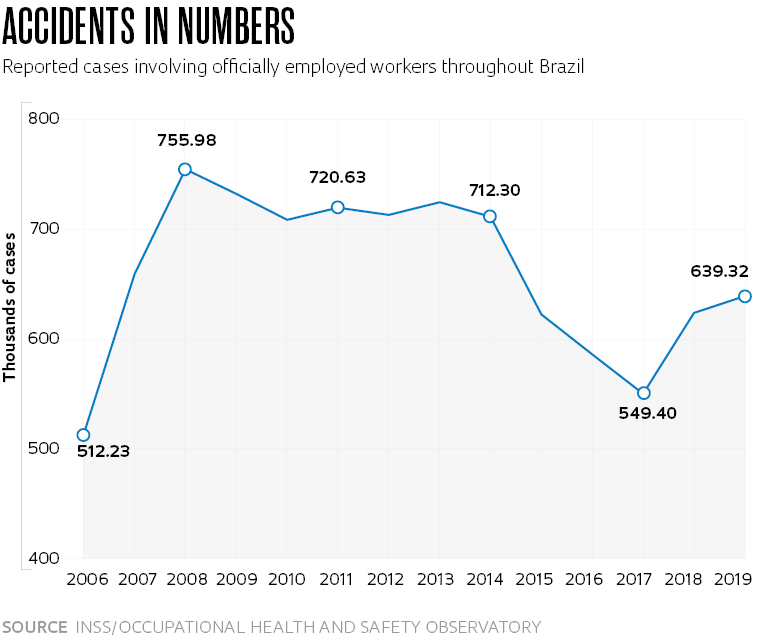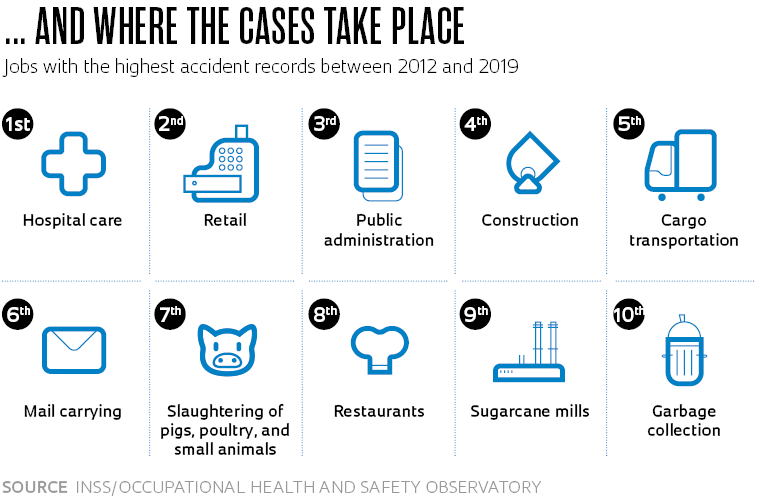Items stocked on supermarket shelves, meals delivered by app drivers, and silica extracted to be used as raw material for the electronics industry say nothing about the health of the workers who perform these activities. Recent studies, however, seek to share the reality of the workers in various sectors of the economy, in order to better understand the reasons why thousands of them suffer accidents, get sick, or die when performing their jobs. The researchers we interviewed believe that successful preventive measures hinge on implementing strategies to encourage the participation of employees—which most companies and institutions never bother to do.
“It is necessary to establish dialogue between public authorities, entrepreneurs, managers, scientists, and workers to understand where the contradictions of the professional world lie and how they impact the health of wage earners and employees without a formal employment contract,” says Élida Hennington, a public health physician from the Center for the Study of Worker’s Health and Human Ecology at the Oswaldo Cruz Foundation (CESTEH-FIOCRUZ), in Rio de Janeiro.
She explains that the standard model adopted by many countries, including Brazil, sees workers subjected to health and safety programs designed exclusively by technicians. “Standards are prescribed without considering the demands and needs of those who experience the unforeseen events and adversities of a given trade,” says Hennington. “Neoliberal policies and the economic downturn, even before the pandemic, have intensified phenomena such as precarious labor, the weakening of labor rights, and a lower investment in preventive actions, increasing the risk of occupational accidents and diseases.”
“This is why caring for workers’ health means taking into account historical and socioeconomic aspects,” argues engineer Rodolfo Andrade de Gouveia Vilela, from the School of Public Health at the University of São Paulo (FSP-USP). Vilela states that even seemingly simple accidents cannot be attributed to a single employee’s error or carelessness. He believes immediate setbacks are only the tip of the iceberg. “We have what we call latent conditions, that is, ‘the causes of the causes’ of problems, which lie at the organizational level of the company.” Therefore, he says, blaming the victim reinforces a reductionist perspective—a convenient defense for the company against employee lawsuits.
Implementing a culture of safety must include collective surveillance actions that can effectively transform working conditions, assesses Vilela, who has, since 2006, led research on alternatives to the conventional prevention model—generally based on one-way, top-down communication. A FAPESP-funded project, led by the researcher, has been achieving concrete results. “The key outcome is the improvement and implementation of a new methodology to identify potential health risks for employees and, with their help, generate systemic responses that take into account the specific needs of each workplace,” he explains.
However, the method called Laboratório de Mudanças (Change Laboratory) is far from being a roadmap of standardized recommendations, warns Vilela. “We propose that, through workshops, researchers act as facilitators of learning and cooperation among various actors in the same institution or company.” The approach has been implemented in different production and service sectors and has been gaining strength in a branch of Fundação Casa—a youth detention center in Campinas, in the state of São Paulo.

“In 2015, we received a series of reports of physical and psychological violence inflicted on employees of the institution,” says Silvio Beltramelli Neto, a prosecutor at the Public Labor Prosecutor’s Office and professor of law at the Pontifical Catholic University of Campinas (PUC-Campinas). “Since we were already familiar with Vilela’s work, we decided to join forces to find a solution to the problems that afflicted the health of those workers.”
The first step taken by the FSP-USP team was conducting an ethnographic survey at the facility, which included observing the daily work environment, allowing for a detailed analysis of the dynamics of the directors, employees, and the teenage inmates. “We observed a stressful environment, which included harassment and both physical and verbal abuse,” says Beltramelli. In this environment, the employees were always in place of insecurity and “putting out fires.”
The group of researchers investigated historical and cultural aspects that could provide clues to the origins of the conflicts. They noted that the workers perpetuated the violent practices learned from the model of the former State Foundation for the Well-being of Minors (FEBEM), which has been replaced with the Fundação Casa. “Although social and educational activities were offered to the inmates, such as vocational training, the employees repeated practices such as excessive punishment and ‘containment measures’ when handling the adolescents,” says Vilela.
The inmates were subjected to daily, thorough intimate searches. “This practice discourages healthy bonding between the employees and the inmates,” says Vilela, pointing out that, without such bonding, resocialization is compromised. “All of this contributed to the employees getting sick, as they did not have the emotional support to handle the complexity of that environment.” Gradually, they built a space for dialogue between the employees, the inmates, and the members from the institution’s multidisciplinary team. “The inmates were no longer seen as criminals by the employees, who, in turn, began working more closely with the institution’s pedagogues and social workers, which helped them welcome and care for the young inmates,” points out Beltramelli.
The results of this experiment are still being tested and consolidated, but initial improvements in the workers’ well-being is already being recognized, says Vilela, based on testimonials from the employees themselves. “We are observing a gradual reversal of the vicious cycle of violence that has been prevalent there.”
The idea behind the Laboratório de Mudanças was conceived in the 1990s, by researchers at the University of Helsinki in Finland. Since then, the method has been applied in hospitals, schools, and infrastructure projects in more than 30 countries. “This approach helps participants from different hierarchical levels to identify historical contradictions in an environment and test out solutions to overcome these obstacles,” explains Vilela. “In this process, more humane productive systems emerge.”

Physician Luiz Carlos Fadel, a researcher at the Department of Human Rights, Health, and Cultural Diversity at FIOCRUZ, is optimistic about the initiative. However, he has some reservations: “For it to become large enough to produce concrete transformation in large companies, local problems, identified ’on the factory floor,’ must be correlated with global challenges that directly or indirectly influence the health of workers, such as an increase in financialization related to the economy.”
Fadel believes that, in this process, companies adopt strategies to reduce costs and increase shareholder profits in the short term. “This logic produces a very violent work environment, which stimulates competition among workers through increasingly aggressive goals and workloads.” In this context, says Fadel, employees are more likely to experience health problems over time, such as muscle pain and hearing loss from intense noise. “Furthermore, overworked employees can also develop mental disorders such as anxiety and depression.”
Working long hours is also associated with the onset of cardiovascular disease, according to a global study by the World Health Organization (WHO) and the International Labor Organization (ILO), published in May in the journal Environment International. These organizations estimate that, in 2016, 398,000 people died from stroke and 347,000 from heart disease as a result of working at least 55 hours a week. This represents a 29% increase since 2000.
The research concludes that working 55 hours or more per week increases the risk of stroke by 35%, and the chances of death from ischemic heart disease by 17%, compared to working a 35- to 40-hour week.
The degradation of working conditions is also reflected in the increased number of work-related accidents and diseases reported in Brazil in recent years. The number rose from 512,000 in 2006 to 639,000 cases in 2019, with some variations in the period (see chart), according to information from the Occupational Health and Safety Observatory, an initiative of the Public Ministry of Labor and the International Labor Organization.
Furthermore, from 2012 to 2020, 21,460 workers suffered fatal accidents in Brazil, meaning six deaths for every 100,000 official jobs. In 2020, the year the COVID-19 pandemic began, serious cases reported to the Ministry of Health rose by 40%, mostly from coronavirus infections, motorcycle accidents, and severe injuries caused by machinery and equipment.

The sectors with the highest number of accident reports between 2012 and 2020 are hospitals, retail, construction, cargo transportation, and meat packing. The survey (available at smartlabbr.org/sst) uses data compiled by the National Institute of Social Security (INSS) and only records accidents of those hired under the Consolidation of Labor Laws (CLT) regime.
The observatory has also made available a separate set of data from the Ministry of Health’s Notifiable Diseases Information System (SINAN), which indicates that accident reports have risen from 62,000 in 2007 to over 200,000 in 2019. “SINAN covers a wider range of the working population,” explains Hennington from CESTEH-FIOCRUZ. This is because it gathers data on care provided to injured workers in the Unified Health System (SUS), regardless of whether they have been officially hired or not. “We can assume, therefore, that accidents and illnesses in the unofficial economy have been reported more often, enabling effective strategies for prevention and health preservation.”
There is, indeed, an increasing portion of the labor force that is not officially hired by companies. According to the Brazilian Institute of Geography and Statistics (IBGE), the rate of unofficial workers in the country has reached 39.6%, with more than 34 million workers counted between December 2020 and February 2021. In the previous quarter, the rate was 39.1%.
The Occupational Health and Safety Observatory survey also shows that, since 2012, spending related to accidents has reached R$100 billion. The total amount spent on sick days due to depression, anxiety, and other mental disorders rose from 224,000 in 2019 to 289,000 in 2020. “It is clear, therefore, that workplace accidents have a financial impact on the market, on social security, and on the SUS,” says Sayuri Tanaka Maeda, a professor at the USP School of Nursing. Maeda, alongside her master’s student Cléria Silva Marinho, investigated the economic consequences of workplace accidents in Piracicaba (in the state of São Paulo), in collaboration with the city’s Center for Employee Health Benchmarking (CEREST).
The study results are yet to be published, but Maeda says that the public and private health care systems spent R$2.3 million during the period they studied, from January to December 2014. In total, they reviewed 8,953 accidents treated in public hospitals and 1,159 accidents in private hospitals. “We observed that 75% of them were treated by the SUS, and a little over 90% of the cases involved officially employed workers.” Most accidents involved general assistants, machine operators, drivers, welders, and construction workers.
Often, their invisibility contributes to making them ill, as portrayed in the minidocumentary Varredeiras (Sweepers), released last March: the result of a 2020 master”s research project by psychologist Bianca Gafanhão Bobadilha, as part of the thematic project coordinated by Vilela at FSP-USP. Faced with cases of accidents and illnesses involving the women that sweep the streets of Piracicaba, Bobadilha established open lines of communication between the female employees and the managers of the urban cleaning company that employed them, in an effort to apply the Laboratório de Mudanças method.
After meeting with a few of the sweepers, the researcher found that one of their challenges was how little recognition they got for their work. In addition to a lack of security, social prejudice was also listed as an important contributor to emotional distress and stress.
One of the solutions found, beyond negotiating better working conditions with the company, was to produce the documentary to show the sweepers’ daily routine and raise awareness. “There is still some resistance from the company to listen to other issues raised by the workers, such as defining the mapped area they must cover each working day. However, the female employees are now heard more, and this can bring about considerable organizational change,” says Vilela, who followed the work done in Piracicaba. The film, which involved the sweepers every step of the way, will be shown in schools and other interested institutions.
Projects
1. Innovation and transformation in professional risk prevention – ITAPAR (nº 19/13525-0); Grant Mechanism Thematic Project; Principal Investigator Rodolfo Andrade de Gouveia Vilela (USP); Investment R$632,977.56.
2. Accidents at work: from socio-technical analysis to the social construction of change (nº 12/04721-1); Grant Mechanism Thematic Project; Principal Investigator Rodolfo Andrade de Gouveia Vilela (USP); Investment R$976,019.61.
3. Economic consequences of workplace accidents: reality in the municipality of Piracicaba (nº 15/20230-6); Grant Mechanism Research Grant; Principal Investigator Sayuri Tanaka Maeda (USP); Investment R$21,545.
Scientific article
PEGA, F. et al. Global, regional, and national burdens of ischemic heart disease and stroke attributable to exposure to long working hours for 194 countries, 2000–2016: A systematic analysis from the WHO/ILO Joint Estimates of the Work-related Burden of Disease and Injury. Environment International. May 2021.
Book
VILELA R. et al. (org). Desenvolvimento Colaborativo para a Prevenção de Acidentes e Doenças Relacionadas ao Trabalho. Laboratório de Mudança na Saúde do Trabalhador. Ex Libris SP. 2020.


